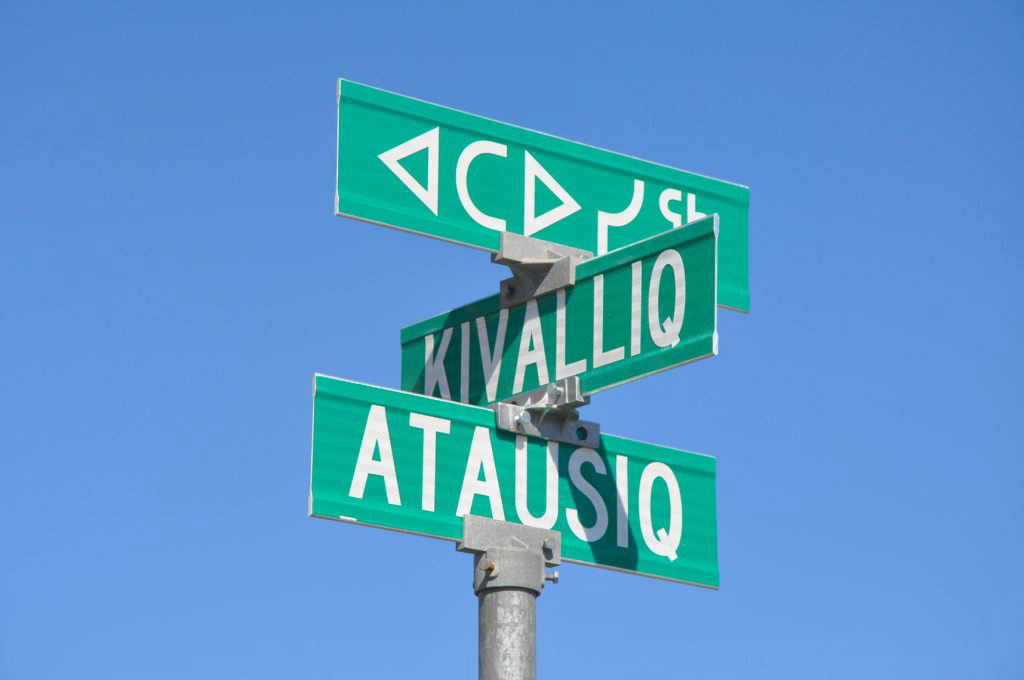An Inuit organization is encouraging Nunavut hamlets to reclaim their Inuktut names
The move is part of broader efforts to protect and revitalize Inuktut which have seen a boost this year, as 2019 was named the International Year of Indigenous Languages by the UN.

What’s in an Inuktut name?
The reclaiming of Inuit history and language, Nunavut Tunngavik Inc. says.
The Inuit birthright organization has encouraged 14 municipalities in the territory that still use English names to consider a switch to their original Inuktut names.
“With 2019 being the International Year of Indigenous Languages, one of the things we’ve focused on is Inuktut-language rights,” said NTI president Aluki Kotierk, “and how to ensure that Inuit are able to receive essential public services in Inuktut.”
“I thought this would also signal to Canada and even beyond that Inuit were reclaiming and asserting their language rights.”
Many Nunavummiut already refer to their communities by their Inuktut names, Kotierk noted, but this is a way to make those traditional names official.
Nunavut Tunngavik Inc. sent out letters to 14 municipalities that still use their English names in March 2019, encouraging them to consider the change, and explaining the process.
Under the territory’s Hamlet Act, a council can make a request for a name change to the minister of Community and Government Services.
There are a number of examples of that happening, most recently in 2015, when Repulse Bay went through the process to re-name the municipality Naujaat.
A handful of other communities did the same through the 1980s and 1990s, before Nunavut was created, including Iqaluit (formerly Frobisher Bay), Kugluktuk (Coppermine), Kimmirut (Lake Harbour), Qikiqtarjuaq (Broughton Island) and Kugaaruk (Pelly Bay.)
Cape Dorset is one community considering the change. The Baffin municipality was named by a British captain after the fourth Earl of Dorset in the 1600s, but is commonly known by its Inuktut name, Kinngait.
Some residents also refer to the community as Sikusilaq, after the nearby inlet that remains ice-free throughout the year.
Over the last few months, the hamlet council has launched a discussion with community members over radio and social media, to gauge interest in renaming the hamlet.
Hamlet officials plan to include an informal ballot during the fall municipal elections, in which voters can indicate if they are for or against the name change.
Kotierk said she’s also heard interest from Coral Harbour’s hamlet council, as well as Cambridge Bay, which is consulting local elders about a potential name change.
“It has to come from the community,” she said.
The United Nations named 2019 as the International Year of Indigenous Languages, highlighting the need to preserve, revitalize and promote the use of the world’s estimated 7,000 Indigenous languages — 2,680 of which are considered to be in danger.
Kotierk said NTI has used the occasion to “make a lot of noise” about the urgent need to protect and promote the use of Inuktut in Nunavut, pressing both the territorial and federal governments to implement safeguards.
In some cases, there are a number of different Inuktut names that are used in Nunavut communities; there is no official list of Inuktut names by which communities were once to referred to.
Below is a list of Nunavut communities that still use English names, along with their common Inuktut names:
- Cambridge Bay (Ikaluktutiak)
- Gjoa Haven (Uqsuqtuuq)
- Hall Beach (Sanirajak)
- Baker Lake (Qamaani’tuaq)
- Chesterfield Inlet (Igluligaarjuk)
- Rankin Inlet (Kangiqliniq)
- Whale Cove (Tikiraqjuaq)
- Coral Harbour (Salliq)
- Clyde River (Kaniqtugaapik)
- Pond Inlet (Mittimatalik)
- Arctic Bay (Ikpiarjuk or Tununirusiq)
- Grise Fiord (Ausuittuq)
- Resolute Bay (Qausuittuq)
- Cape Dorset (Kinngait)